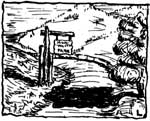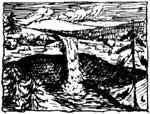
 | ||||||||||
| Intro | Author | Subject | Volume | Volume/Title | NPS | |||||
|
Volume VI - Nos. 1 & 2 |
January-February, 1941 |
|
COORDINATION OF CONSERVATION PROGRAMS BY CARL P. RUSSELL A hard-working married couple, European emigrants, had labored through a short favorable period in America, had prospered, and were returning to the land of their origin. They boarded a ship and traveled in style quite unknown to them when America-bound. Their cup of joy was full until their ship ran into a severe storm. The threat of the elements became heavier and rougher and finally the wife, terribly frightened, made her way to the pitching deck where her husband watched the tempest from the shelter of a glassed-in canopy. "What shall we do," she cried "What shall we do? The ship is going to sink!" "Well, should we worry?" he replied, "Let it sink, it don't belong to us." Beyond question there has been something of the attitude of "it don't belong to us" on the part of a gigantic army of Americans who for three centuries have exploited the natural wealth of the country. Most of us can identify ancestors who in one way or another contributed to the exhaustion of America's natural resources. For generations it was the good old American custom for every citizen to extract from his immediate surroundings all that could be taken and then move on to new fields of exploitation. It was not until 1901 when Theodore Roosevelt became President that a public consciousness of conservation needs was developed. By 1908, conservation ideas had crystallized sufficiently to enable the President to conduct a White House Conference of the Governors of the United States. Explained Theodore Roosevelt: "It seems to me time for the country to take account of its natural resources, and to inquire how long they are likely to last. We are prosperous now; we should not forget that it will be just as important to our descendants to be prosperous in their time." The Conference of the Governors in spite of the later disapproval of Congress accomplished its purpose in awakening general appreciation of conservation needs. In fact the word CONSERVATION entered upon national usage as a result of the conference. The Governors declared:
Probably no common word has greater variety of meanings today than does CONSERVATION. To some people the word always will suggest the Civilian Conservation Corps---those 1,500 camps of young men engaged in the restoration of the nation's depleted natural resources. To others it brings to mind the Soil Conservation Service---the great government bureau established for the purpose of saving our agricultural lands. To the hunter, trapper, and fisherman it means the protection and propagation for profit or sporting purposes of fish and game, a notable program guided by another government bureau, the Fish and Wildlife Service. To the farmer CONSERVATION means management of his woodlands, enrichment of his soil, perpetuation of his grazing lands, and care of his wildlife crop. The miner and petroleum specialist think of health conditions, safety for workers, efficiency and the prevention of waste in mines and the oil fields---conservation activities promoted by the Bureau of Mines, the Petroleum Conservation Division and the U. S. Geological Survey. The forest enthusiast, the lumberman, the paper manufacturer, the naval stores expert and the man who produces wood for fuel look to the U. S. Forest Service for guidance in their conservation matters. The stock grower is conscious especially of the conservation policies defined by the U. S. Grazing Service and the irrigationist looks to the Bureau of Reclamation for his management and policy of practices. The parks enthusiast and recreation leader turn to the National Park Service for leadership in their particular brands of conservation work. 
There are, of course, many other special interests which focus upon the broad program of conservation and as might be expected these special interests have organized for the purpose of promoting their specific programs. I have a list of 178 private or citizen groups concerned with the conservation of natural resources, most of them nation-wide in their activities. The hundreds of local chapters of the Audubon Societies, Izaak Walton League, and the Federation of Outdoor Clubs are not included in this directory. A number of the national organizations publish journals that serve a mighty purpose in spreading the conservation gospel. The Conservation Departments of the 48 states provide a substantial framework upon which the far flung program of planning and management finds support, and out of the maze of interpretations of what it is all about has emerged a generally accepted definition of conservation, --- "wise use which recognizes our renewable natural resources as a crop and treats them as such." Hundreds of thousands of workers engage in the practical business of conserving our natural resources. Direction and coordination of this great army centers largely in the ten federal agencies previously mentioned; the Civilian Conservation Corps, the Soil Conservation Service, the U. S. Forest Service, the Fish and Wildlife Service, the Bureau of Mines, the Petroleum Conservation Division, the U. S. Geological Survey, the U. S. Grazing Service, the Bureau of Reclamation and the National Park Service. Within these units of the Federal government has developed a national plan under which citizens, institutions, states, and the national executives unite to conserve the natural values of America. Many readers are acquainted with the plan of the President's Committee on the reorganization of executive departments. This committee has recognized conservation as a first objective of government quite as did Theodore Roosevelt in his first message to Congress in 1901. The present committee on reorganization has recommended the creation of a Department of Conservation to replace the Department of the Interior. Five years ago when President Roosevelt laid the cornerstone of the new Interior Building in Washington, he dedicated the structure to conservation. He said:
At the time of the first budget hearings following the dedication of the Interior Department Building, Secretary Ickes made this statement:

In the five years that have elapsed since the new Interior Building was dedicated some notable advances have been made to overcome the obstructions created by overlapping jurisdictions, bureaucratic jealousies, waste and inefficiency. The Biological Survey, the Bureau of Fisheries, and that part of the Soil Conservation Service which has to do with conservation on the public domain, have been transferred to the Department of the Interior. Seven of the ten major government agencies principally concerned with the Nation's conservation program now are under the administration of the Secretary of the Interior. There are some 250 million acres of the public domain in the continental United States under the Department of the Interior, an area larger than that administered by any other Department. The goal of coordinated effort has been more closely approached than ever before in the history of conservation in America. Good cooperation between public institutions, between the states themselves, between the states and nation, and between the agencies of the national government bids fair to provide the potent set-up required to effect true conservation of our natural resources. The recognition of a Department of Conservation, however, is still a desideratum. As might be expected, it is that phase of conservation work done by the National Park Service which interests us most. By mandate of Congress the National Park Service is responsible for the conservation of the scenery and all of the natural and historic objects within the national parks and national monuments. In the same breath, so to speak, the law which provides for the preservation of the native values also orders that the parks and monuments shall be thrown open to visitors. We must preserve the areas unimpaired yet within them we must entertain the public--a crowd of national parks enthusiasts which each year grows more tremendous. Last year 16-1/2 million visitors used the national parks and monuments. Obviously this horde of people cannot be accommodated in the wilderness parks without some impairment of natural values. The great problem of the National Park Service becomes one of judgment as to how to minimize that impairment. The question of roads and trails, for example, is always before us. There is an insistent demand to make every nook and corner in the national parks easily accessible by automobile. The vast majority of park visitors will not walk a half mile away from the roads, hotels, and lodges. Secretary Ickes has made a positive statement of policy in this connection:

Numerous attempts have been made by some selfish interests to discard entirely the primary purpose of the National Park Service, the preservation of native values, in order that dams may be built for the impoundment of water within the parks; in order that mines may be developed or magnificent timber may be marketed. During the last World War pressure was exerted in the name of national need which resulted in the opening of certain western parks to cattlemen. War-time permits were granted to graze cattle in some of the parks just for the duration of the War but ten years elapsed before the grazing foothold gained under the guise of emergency could be broken, and it took nature many more years to restore the normal vegetation after the last steer was driven from the parks. It is important to note, too, that grazing in national parks cannot influence the economic situation in any important way. For example, in Sequoia National Park emergency permits were granted to graze 2,100 animals in the mountain meadows of that Sierra wonderland. One section--640 acres--of irrigated lands of the San Joaquin Valley would have supported more cattle than could have grazed on the entire area--many thousand of acres---of the national park. The present strained situation of the nation holds new threats of raids on the national parks. Actually the parks contain little that will be needed should a crisis arise but there will be attempts made by impetuous citizens, well-meaning citizens, perhaps, but unwise in their disregard of the precious cultural nature of national park values. And, in all probability there will be demands from those purely selfish individuals who under the guise of patriotism will seize for their personal gain such water rights, timber lands, mineral prospects, and grazing privileges as can be filched from the government. In 1916 the Olympic National Park project had progressed to a point which permitted of the introduction of legislation to establish the park. Perhaps the bills would have passed had there been no opportunity to sell airplanes. The Sitka spruce of the Olympic region was in demand for the manufacture of airplanes--and the proposed park area contained stands of the valuable timber. The park was not created, but thousands of Sitka spruce trees were cut. Many of them today lay right where they were felled during World War I. It proved to be impractical to move them to the mills. Olympic National Park waited 22 years for the action that finally placed it in the galaxy of wonderlands administered by the National Park Service. Employees of the National Park Service are sane in their duty to the nation. Not one of them would advocate the withholding of any park resource if it were needed to preserve America. But the incident of the waste of the Sitka spruce of the Olympic Peninsula provides a fair example of the unwise action that may be taken under pressure. The same forces that worked against conservation in 1916 may be felt again in the near future. Perhaps with all of us working together, we can forestall attacks on our national parks and on other resources upon which the welfare of our homeland largely rests. This can be done only by arousing an enlightened public opinion. The contribution that national parks, state parks and historic shrines can make to the preparedness of the national mind is just now receiving the careful consideration of statesmen and conservationists, generally. It has become apparent that an important educational aspect is to be found in the public enjoyment of parks; that scenic and scientific appreciation, historical-mindedness, and national patriotism are intensified through their use. The National Park Service and many state park organizations have committed themselves to a policy of preserving, and presenting by striking examples, the comprehensive and varied story of earth forces and the progress of civilization in this country. From the standpoint of scope, the park programs now connect and constitute expression of much that is essentially American. In short, the national parks and state parks are situated most advantageously to develop a national perspective in social traditions and esthetic appreciation of all that America has and stands for. Making the wealth of national expression accessible and understood to millions of citizens is the great opportunity of federal and state park officials. Conclusion The era of the "cut down and get out" policy on natural resources in America is coming to a close. Public consciousness of conservation needs has been awakened and there still remains a vast hoard of wealth in the nation's natural coffers. Government bureaus, state agencies and hundreds of private organizations have defined a common objective of protection and wise use. A large part of the conservation program in America is coordinated in the Department of the Interior. It is recommended by the President that the name of this Department be changed to the Department of Conservation. Such recognition of a distinct conservation unit in the executive set-up of the government would
The philosophy of American conservation education is the philosophy of democracy. The parks program, national and state, may be one of the potent agencies in imparting an understanding of conservation objectives and the fundamental principles of American democracy. It works ideally toward preparedness of the national mind. BIBLIOGRAPHY Oscar L. Chapman, "Conservation" , American Planning and Civic Annual, pp. 216-220, 1939. Treadwell Cleveland, Jr., A Primer of Conservation. (Declaration of principles of conservation, Conference of the Governors, the White House, May 13-15, 1908). Charles N. Elliott, Conservation of American Resources. Turner E. Smith and Co., Atlanta, pp. 11-672. 1940. Harold L. Ickes. Address delivered over the National Broadcasting Co., Nov. 1, 1937., Congressional Record, Nov. 19. 1937. Appendix pp. 324-325. Harold L. Ickes. Address delivered at a dinner at the Olympic Hotel, Seattle, Washington, Aug. 26, 1933. Mimeographed. pp. 1-13. U. S. Department of the Interior. Dedicated to Conservation. (New Interior Building Dedication, Apr. 16, 1936). Government Printing Office, Washington, D. C. pp. 1-20. | |
| <<< Previous | > Contents < | Next >>> | ||
|
http://www.cr.nps.gov/history/online_books/regional_review/vol6-1-2e.htm Date: 04-Jul-2002 | ||||